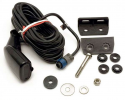- Joined
- Jun 25, 2015
- Messages
- 65
- Reaction score
- 26
- Points
- 18
- Location
- Northern California
- Model
- Seafarer
I have an '2004 - 228 and thanks to everyone on here for guideance.
I am no DIU'er but do try my best.
Just had the 250 Suzuki serviced and had them replace the scuppers based on advice here - they have been the same ones since i have had this sled for the past ten years. Maybe never replaced.
The tansducer for the HDS 7 was replaced last year as it broke off and would lose reading at about 15mph. The reading problem has beed going on for years.. When it was repaired I would get the readings at all speeds but that did not last long.
At this years service they just cleaned the transducer and I hoped it would get good readings but on the way back to the marina the same thing happened again - no readings above 15 mph.
Perhaps this is a grounding issue, corusion issue or from the outboard.
I was going to replace the unit with the one Mustange65 has last year but really do not need a different unit for help with finding the fish. Just need readings to stay out of the mud.
Appreciate any thoughts about the hds - 7
thanks so much.
steve
I am no DIU'er but do try my best.
Just had the 250 Suzuki serviced and had them replace the scuppers based on advice here - they have been the same ones since i have had this sled for the past ten years. Maybe never replaced.
The tansducer for the HDS 7 was replaced last year as it broke off and would lose reading at about 15mph. The reading problem has beed going on for years.. When it was repaired I would get the readings at all speeds but that did not last long.
At this years service they just cleaned the transducer and I hoped it would get good readings but on the way back to the marina the same thing happened again - no readings above 15 mph.
Perhaps this is a grounding issue, corusion issue or from the outboard.
I was going to replace the unit with the one Mustange65 has last year but really do not need a different unit for help with finding the fish. Just need readings to stay out of the mud.
Appreciate any thoughts about the hds - 7
thanks so much.
steve



